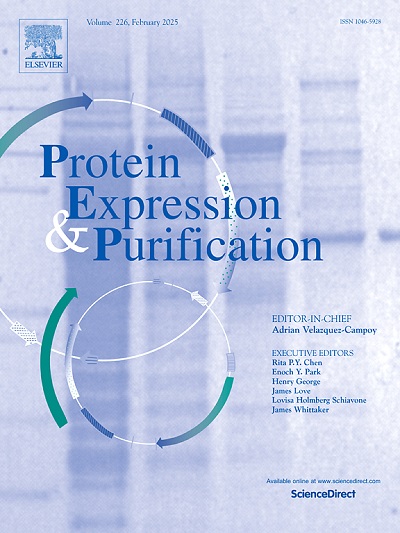Diverse approaches to isolate HLA class I molecules from bacterial inclusion bodies, forming heterotrimeric complexes
IF 1.4
4区 生物学
Q4 BIOCHEMICAL RESEARCH METHODS
引用次数: 0
Abstract
Production of recombinant human leukocyte antigen class I (HLA-I) proteins in vitro is fundamental for molecular immunology. However, HLA-I protein refolding has remained inefficient due to challenges in the assembling of the trimolecular complex. Here, we compare various in vitro refolding methods that address the challenges of intrachain disulfide bond formation and assembly of the complex between the light and heavy chains in the presence of the target peptide. We developed methods that uncouple the oxidation of disulfide bond formation of both subunits of HLA-I, followed by renaturation to promote complex formation. CuSO4-catalyzed air oxidation enhances correct disulfide bond formation when the protein is solubilized with N-lauryl-sarcosine (sarkosyl); however, careful removal of sarkosyl did not prevent heavy chain aggregation. We modified the classical method of HLA-I refolding by pre-oxidizing the β2m light chain before adding the HLA-I heavy chain and peptide. This method yielded successful complex refolding for HLA-A∗02:01/GILGFVFTL at 24.2 % efficiency, and HLA-C∗12:03/KAYNVTQAF at 14.5 % efficiency. Our results suggest that pre-folded β2m improves refolding efficiency of HLA-I molecules. This work presents novel approaches to HLA-I refolding that may be applied to other difficult-to-fold protein complexes.
从细菌包涵体中分离HLA I类分子的多种方法,形成异源三聚体复合物。
体外生产重组人白细胞抗原I类(HLA-I)蛋白是分子免疫学的基础。然而,由于三分子复合物的组装挑战,hla - 1蛋白的重折叠仍然效率低下。在这里,我们比较了各种体外重折叠方法,这些方法解决了在目标肽存在下链内二硫键形成和轻链和重链之间复合物组装的挑战。我们开发了一种方法,使hla - 1的两个亚基的二硫键形成的氧化解耦,然后再进行还原以促进复合物的形成。当蛋白质与n -月桂基肌氨酸(sarkosyl)溶解时,cuso4催化的空气氧化增强了正确的二硫键形成;然而,仔细去除萨科齐并不能防止重链聚集。在加入hla - 1重链和肽段之前,先对β2m轻链进行预氧化,对经典的hla - 1重折叠方法进行了改进。该方法对HLA-A*02:01/GILGFVFTL和HLA-C*12:03 /KAYNVTQAF的复折叠效率分别为24.2%和14.5%。我们的研究结果表明,预折叠β2m提高了hla - 1分子的再折叠效率。这项工作提出了hla - 1再折叠的新方法,可应用于其他难以折叠的蛋白质复合物。
本文章由计算机程序翻译,如有差异,请以英文原文为准。
求助全文
约1分钟内获得全文
求助全文
来源期刊

Protein expression and purification
生物-生化研究方法
CiteScore
3.70
自引率
6.20%
发文量
120
审稿时长
32 days
期刊介绍:
Protein Expression and Purification is an international journal providing a forum for the dissemination of new information on protein expression, extraction, purification, characterization, and/or applications using conventional biochemical and/or modern molecular biological approaches and methods, which are of broad interest to the field. The journal does not typically publish repetitive examples of protein expression and purification involving standard, well-established, methods. However, exceptions might include studies on important and/or difficult to express and/or purify proteins and/or studies that include extensive protein characterization, which provide new, previously unpublished information.
 求助内容:
求助内容: 应助结果提醒方式:
应助结果提醒方式:


